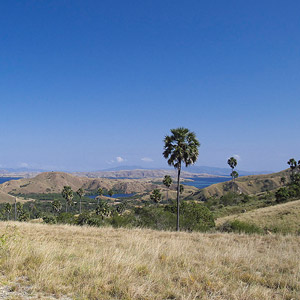Magazine | Voyages
Les oiseaux de Komodo et de Rinca, deux îles de la Wallacea

Savane à Palmiers de Palmyre (Borassus flabellife) sur l’île de Rinca (Indonésie).
Photographie : N. Kenji
Introduction
La Wallacea est la zone biogéographique de transition entre les faunes asiatique et australasienne : son nom vient de celui du naturaliste Alfred Wallace qui avait noté le caractère distinct des animaux vivant sur les îles situées à l’est du Détroit de Lombok.
Elle est composée de nombreuses îles, dont les petites îles de la Sonde, d’origine volcanique. Komodo et sa voisine Rinca en font partie.
Grâce à leurs savanes arborées typiques, à leurs fonds sous-marins très riches et surtout à la présence du Dragon de Komodo, elles ont été incluses dans un parc national. Si les touristes viennent surtout sur ces îles pour voir le fameux varan géant, elles possèdent également une avifaune intéressante composée d’oiseaux d’origine asiatique et australasienne. La « vedette » est la sous-espèce parvula du Cacatoès à huppe jaune, dont la population de Komodo est considérée comme la dernière de taille conséquente.
Nous remercions N. Kenji (voir sa galerie sur Flickr) pour nous avoir aidés à illustrer cet article.
Abstract
The Wallacea represents the biogeographical transitional zone between the Sundaland to the west and the Australasian zone to the east. This zone covers about 338 494 km² land area in total, divided in multiple small islands, including the Lesser Sunda Islands. Lying 200 nautical miles east of Bali, Komodo National Park nestles between Sumbawa and Flores, two of the largest islands of the Lesser Sunda, and includes two main islands, Komodo and Rinca. Their generally steep and rugged topography reflects the position of the national park within the active volcanic ‘shatter belt’ between Australia and the Sunda shelf. The predominant vegetation type is open grass-woodland savannah, mainly of anthropogenic origin, which covers some 70% of the park. The dominant savannah tree is lontar palm, which occurs individually or in scattered stands. Tropical deciduous (monsoon) forest occurs along the bases of hills and on valley bottoms.
The park is best known for the Komodo Dragon, the world’s largest living lizard. But 72 species of birds have been recorded, including the very rare parvula yellow-crested cockatoo, and other interesting species of Asian and Australasian origins.
Poursuivez la lecture de cet article, en vous abonnant dès maintenant !
Découvrez les Archives d’Ornithomedia.com
Pour seulement 10,00 €TTC/an (ou 6,00 € les 6 mois)
Profitez de plusieurs centaines d’articles en accès illimité et sans aucun engagement.
Compléments
À lire sur le web
La galerie de photos de nkenji
Ouvrages recommandés
- A Photographic Guide to the Birds of Indonesia de Morten Strange
- A Field Guide to the Birds of South-East Asia de Craig Robson (30 janvier 2009)
- Carte Bali, Lombok & Komodo 1: 150 000
Sources
- M. JERI IMANSYAH, DENI PURWADANA and TIM S. JESSOP (2008). First records of Wallace’s Hanging-parrot Loriculus flosculus from Rinca Island, Komodo National Park, Indonesia. Forktail (24)
- UNESCO. Parc national de Komodo. http://whc.unesco.org/fr/list/609/
- Burung Nusantara. Birding on Komodo & Rinca. http://burung-nusantara.org/birding-sites/lesser-sundas/komodo/
- Siti Nuramaliati Prijono. Case study : Cacatua sulphurea. WG6. Comisión Nacional para el Conocimiento y Uso de la Biodiversidad. http://www.conabio.gob.mx
- M. JERI IMANSYAH, DENI PURWANDANA, ACHMAD ARIEFIANDY, Y. JACKSON BENU, TIM S. JESSOP et COLIN R. TRAINOR (2008). Preliminary Population estimates of the critically endangered Yellow-crested Cockatoo Cacatua sulphurea on Komodo Island, Indonesia. http://ekologi.wordpress.com





Aucun commentaire sur ce sujet
Participer à la discussion !